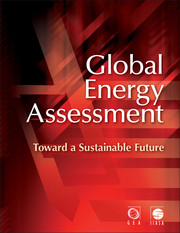Book contents
- Frontmatter
- Contents
- Section 1
- Section 2
- Section 3
- Cluster 1
- Cluster 2
- Chapter 7 Energy Resources and Potentials
- Chapter 8 Energy End-Use: Industry
- Chapter 9 Energy End-Use: Transport
- Chapter 10 Energy End-Use: Buildings
- Chapter 11 Renewable Energy
- Chapter 12 Fossil Energy
- Chapter 13 Carbon Capture and Storage
- Chapter 14 Nuclear Energy
- Chapter 15 Energy Supply Systems
- Chapter 16 Transitions in Energy Systems
- Cluster 3
- Cluster 4
- Section 4
- Index
- References
Chapter 16 - Transitions in Energy Systems
Published online by Cambridge University Press: 05 September 2012
- Frontmatter
- Contents
- Section 1
- Section 2
- Section 3
- Cluster 1
- Cluster 2
- Chapter 7 Energy Resources and Potentials
- Chapter 8 Energy End-Use: Industry
- Chapter 9 Energy End-Use: Transport
- Chapter 10 Energy End-Use: Buildings
- Chapter 11 Renewable Energy
- Chapter 12 Fossil Energy
- Chapter 13 Carbon Capture and Storage
- Chapter 14 Nuclear Energy
- Chapter 15 Energy Supply Systems
- Chapter 16 Transitions in Energy Systems
- Cluster 3
- Cluster 4
- Section 4
- Index
- References
Summary
Executive Summary
This chapter examines the theme of transitions in energy systems. It assesses the literature that explores the genesis, growth, and management of transitions. This literature provides a multi-level framework for large-scale, transformative change in technology systems, involving a hierarchy of changes from experiments to niches to technology regimes.
The chapter also covers specific innovation systems and experiments in the energy sector that may have the potential for larger impact and could lead to new niches or technology regimes. These experiments include technology-driven innovations in generation and end-use; system-level innovations that could reconfigure existing systems; and business model innovations centered on energy service delivery. Experiments in generation include hybrid systems, where multiple primary energy sources help address issues such as intermittency. Experiments in end-use include technology options for the simultaneous delivery of multiple energy services, or energy and non-energy services. System-level experiments include innovations in storage, distributed generation, and the facilitation of energy efficiency by effectively monetizing savings in energy use.
In some of these experiments, technology can lead to changing relationships between actors or changing roles for actors; for example, the process of consumers becoming producers is seen in small-scale biogas projects. These changing relationships present both challenges and opportunities for influencing the transition process. The chapter also discusses policy and institutional issues that affect transitions. Finally, it is seen that although technological research, development, and innovation are important, a wide-scale, equitable, and accessible transformation to energy systems for sustainable development needs to be tackled as a socio-political issue.
- Type
- Chapter
- Information
- Global Energy AssessmentToward a Sustainable Future, pp. 1173 - 1202Publisher: Cambridge University PressPrint publication year: 2012
References
- 1
- Cited by



